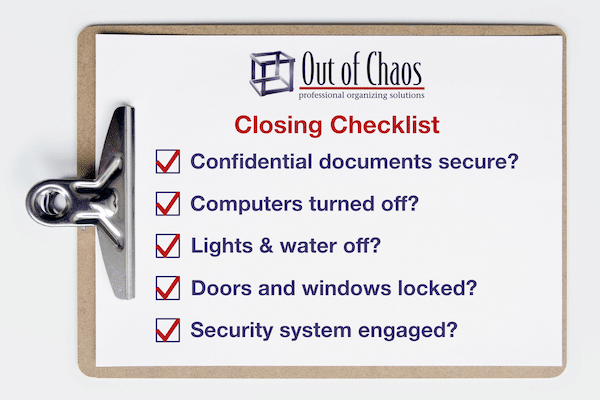
Many of us have repetitive tasks to complete. Some tasks we do almost every day. When we are busy or distracted, we may forget certain steps in a process. Other tasks, we only do occasionally. While we certainly have the skill to complete the task, we can’t always remember every step. Usually, things are alright – except when a crisis occurs. Then we can run into trouble trying to juggle too many things at once. However, there is a magic solution to these problems. It’s the power of the checklist.
Why Checklists
Life today is complicated. Our homes have many more gadgets. The amount of stuff (mental clutter) to remember today is overwhelming. We screw up. We make mistakes. The frustrating thing is that we have the knowledge and skill to deal with complex problems, but we often forget to apply what we know properly and in a timely manner. Even if someone is an expert, there is too much, complicated information to rely on memory alone. Using the power of the checklist means we can apply the knowledge we have consistently and correctly.
Types of Checklists
According to the research in the book, The Checklist Manifesto, there are two main types of checklists: READ-DO and DO-CONFIRM
READ-DO checklists are what we are most familiar with. We read the list and perform the task. Following a recipe is a good example of a read-do checklist. Read-do checklists are valuable. They allow you to delegate tasks to other team members and ensure that when those tasks are performed they will meet a minimum standard.
DO-CONFIRM checklists are different. We do a job from memory and experience. Then, we get to a pause-point and run through our list. For example, just before you leave your office at the end of the day you might run through this checklist:
- Confidential documents secure? CHECK!
- Computers turned off? CHECK!
- Lights & water off? CHECK!
- Doors and windows locked? CHECK!
- Security system engaged? CHECK!
The Benefits
By having Read-Do checklists for all processes, you can complete repetitive tasks more quickly and efficiently, and with fewer mistakes. You can see where redundancies are and where you can improve your processes. Do-Confirm checklists allow you to see what points in the process are the most critical and ensure that they are done before proceeding to the next tasks.
One of the biggest causes of error is the failure to communicate at critical moments in a project. Checklists can ensure communication within a team. Specify when and why team members need to meet to either proceed to the next step in a project or decide on a different course of action to complete the project.
By following checklists, we can quickly and easily see patterns of mistakes and failures. This allows us to modify our processes and techniques and revamp our checklists. The result is better management of our resources – time, money, and team members.
People like to think they make great decisions on “gut-feeling.” But in The Checklist Manifesto, the author shows that checklists allow people to make better decisions faster. This is because their checklist ensures they have all the necessary information to make a good decision.
Building Good Checklists
First of all, let’s talk about bad checklists because they seem to be everywhere. Bad checklists are too long with vague, imprecise instructions. They are hard-to-use and unfortunately, often created by people who have never actually performed the job.
Good checklists are precise, short, and easy to use even in the most challenging situations. They list critical steps in a complex process. A good checklist will make priorities clear and help people function better as a team.
A good checklist should:
- Focus on the most critical steps.
- Use language that the users are familiar with.
- Have an easy to read font with upper- and lower-case letters.
- Fit on one piece of paper or an index card.
- Take no more than 60 seconds to complete.
Once you have built your checklist, test it and retest it. Make adjustments where necessary and keep testing it until it works consistently. In addition, you should review checklists regularly to ensure future success.
Don’t Underestimate the Power of the Checklist
Checklists are powerful productivity tools, but they are often disregarded – even scoffed at because they are easy to create and implement. Perhaps it is because we’ve been raised to believe that as intelligent adults we should remember what we’re supposed to do or what we have done.
Maybe we fear that checklists will turn us into unthinking robots unable to improvise and cope with a rapidly changing situation. In fact, the opposite is true. Using checklists allows us to use our brainpower for creative activities – an idea generator not an information storage device. This gives you more time in the day and assures you act rather than react. A checklist’s value is not in checking off boxes. It is to cultivate an environment of productivity, teamwork, and enhanced communication.
On a final note, checklists are not going to replace talent and our ability to improvise. But if we accept the discipline they establish, we will be one step closer to success.
If you want help harnessing the power of the checklist, contact the Out of Chaos team today.
Clipboard image by BRRT on Pixabay.
References
Gawande, Atul. “The Checklist Manifesto: How to Get Things Right. Picador, 2010.

Well said re checklist
Hi Bernadette,
Thank you for your comment and readership. Do let me know if there is a topic that you would like to see us cover in future posts.
Linda